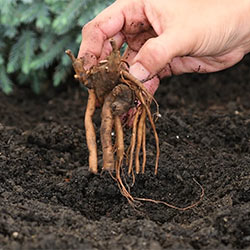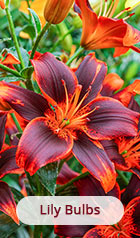Information about Allium
Allium flowers are a striking, easy to care for perennial that will bring color and intrigue to any landscape. Native to Asia, Africa, Central and South America, allium flower bulbs are a splendid and hardy plant with long-living colorful flower heads. These plants also come in varying heights and colors, making it easy to combine them with flowers already present in your yard. We recommend that you combine allium bulbs with German
irises and
daylilies to elevate your garden.
When to plant allium bulbs:
Allium bulbs should be planted in fall, after the first frost and before the ground freezes. Planting after the first frost creates the perfect conditions for planting allium and other small bulb plants. The ground will be warm enough for the bulbs to establish roots, but not so warm that they'll mistake the fall for spring and create shoots.
Keep in mind that not all alliums grow from bulbs! A few, called herbaceous allium, multiply through root clumps like perennials. Herbaceous alliums include allium tuberosum—better known in the vegetable garden as garlic chives—Millenium, Snowcap, and prairie onion varieties. Alliums that grow as perennials can be planted in either spring or fall.
How to plant allium bulbs:
Allium bulbs are incredibly easy to plant, and they're easy to grow. Alliums are actually members of the onion family—anyone who has tried to remove wild onions from their yard knows just how hardy these bulb plants can be! Because they are small, hard bulbs with an onion-like taste, alliums usually aren't bothered by deer. And, their hardy nature means they don't require soil amendments.
When planting your allium bulbs, choose a location with full sun and well-drained soil. Or, select a large planter for growing alliums in a container. Loosen the soil to about ten inches below the surface, to allow your allium bulbs to grow strong roots before their blooming time next spring. Then, plant the bulbs at the depth indicated on their package, cover them with loosened soil, and water them in well. That's truly all the planting care that allium bulbs need!
How deep to plant allium bulbs:
The size of allium bulbs will determine planting depth. Most bulbs should be planted at about two or three times their height so, a small Drumstick allium bulb that is one inch tall will be planted three inches deep. Giant alliums that may be two or three inches tall should be planted deeper, at four to six inches. Be sure to check the packaging on your bulbs for specific instructions.
Where to plant allium bulbs:
Alliums are the perfect "back of the bed" plant, due to their tall height and stately manner. However, these beauties don't need to hide! You can also plant alliums in a clump to create a focal point, or to one side of the garden to balance out a tree or shrub. They thrive in rock gardens, and create a whimsical look when standing tall above pretty pebbles. Or, use them in cutting gardens to have a fresh supply of late-season, globe-shaped blooms perfect for arranging.
When selecting where to plant alliums, consider the plants around these summertime blooms. Alliums bloom in late spring and early summer, along with gladiolus, iris, and many perennials. Giants like Globemaster bloom in May and June, just when your springtime bulbs are fading. To add height alongside early summer perennials and annuals, try smaller, later-blooming varieties like drumstick alliums.
Don't skip out on alliums in containers, either. These are some of the rare tall flowers that have shorter roots: so, you can fill a container with allium bulbs and add lots of height to any patio. Or, try a "double decker" planting, layering allium bulbs in a container with deeper-planted bulbs like tulips. When both varieties sprout, you'll have a gorgeous (and long-lasting!) display.
How to store allium bulbs:
Allium bulbs are winter-hardy and extremely tough, so there's no need to remove them from the ground and store them over winter. But, what should you do if you miss your chance to plant bulbs in the fall? Can you store unplanted alliums until spring?
If the ground is already truly frozen, you can wait until spring to plant your allium: they may not thrive as well as if they were planted in fall, but if planted as soon as the ground can be dug they will grow. If you must store your allium bulbs over winter and plant in spring, the bulbs may not flower the first year. To avoid rot, spread your bulbs in a single layer, and store them in a shallow box or paper bag. Keep your bulbs in a cool, dry location over winter, such as a basement or garage.
You can also pot your allium bulbs for over winter storage and "force" them in the spring, then plant the sprouted bulbs outside. Plant the bulbs in pots and keep them in a cool and dry location. Don't leave them outside to freeze; as containers don't offer the same protection as ground soil. In the spring, you can place the containers outside and allow your allium to grow, then transplant them into the garden.






















